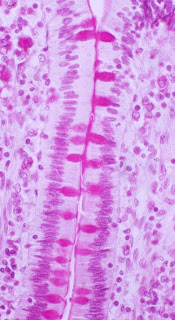https://sites.google.com/site/physiolablist/
The Objectives for this lab are:
- To list at least three functions of the skeletal system.
- To identify the four main kinds of bones.
- To identify surface bone markings and their function.
- To identify the major anatomical areas on a longitudinally cut long bone (or diagram of one).
- To identify the major regions and structures of an osteon in a histological specimen of compact bone (or diagram or model of one).
- To explain the role of the inorganic slats and organic matrix in providing flexibility and hardness to bone.
Hypotheses & Procedures
Part 1: Bone Markings & Classification.
If students examine a variety of disarticulated bones then they will be able to classify them into one of the four anatomical groups: long, short, flat, or irregular and point out examples of bone markings.
Part 2: Gross Anatomy of the Typical Long Bone.
If students examine a fresh cut bone as well as a cleaned dry bone that has been cut along its longitudinal axis, then they will be able to identify the major anatomical structures of a bone as an organ.
Part 3 Microscopic Structure of Compact Bone.
If students observe a prepared slide of ground bone as well as a model of microscopic compact bone, then they will be able to identify the major regions and structures of an osteon.
Part 4: Chemical Composition of Bone:
If students observe a sample of bone that has been baked then they will be able to identify the role of the organic compounds in bone because baking removes the collagen fibers of the matrix.
If students observe a sample of bone that has been soaked in acid then they will be able to identify the role of the inorganic compounds in bone because acids dissolve the calcium salts.
Materials (on lab sheet)
Experiment/Data and lab questions
Part 1: Bone Markings & Classification.
This is a picture of Cameron pointing to an irregular bone
This is a picture of Cameron pointing to the spongy, cancellous part of a long bone
This is a picture of Cameron pointing to the sternum a flat bone.
This is a picture of Cameron holding a long bone.
This is a picture of Cameron holding a short bone.
Insert a picture of each type of bone, with a caption identifying its shape as long, short, flat, or irregular. Within your caption, also identify any bone markings that show up in your picture.
Part 2: Gross Anatomy of the Typical Long Bone.
Insert at least one picture your partner pointing out a specific feature of long bone. Provide a caption to identify the specific feature.
Part 3 Microscopic Structure of Compact Bone.
Copy/paste this image into a draw program (like MS Paint). Label the parts of the osteon that you can identify. Save the image and use it to replace the unlabeled one into your blog, .
Part 4: Chemical Composition of Bone:
Do treated bones retain the structure of untreated specimens?
no because they decay.
Describe what happened to the matrix when the bone was baked. How does this bone feel?
The bone became weak and brittle because they lack collagen
Describe what happened to the matrix when the bone was soaked in acid. How does this bone feel?
Describe what happened to the matrix when the bone was soaked in acid. How does this bone feel?
the acid destroyed the periosteom making it feel softish
Optional: Include a video of your lab team demonstrating the effects of baking and acid on the matrix of bone.
Optional: Include a video of your lab team demonstrating the effects of baking and acid on the matrix of bone.
Conclusion:
- List at least three functions of the skeletal system.
- movement, protection, creating blood cells
- Identify the four main kinds of bones.
- long, short, irregular, flat
- Which surface bone markings and their function can you identify and describe?
- projections show where muscles are pulling on the bone.
- Which major anatomical areas on a longitudinally cut long bone (or diagram of one) can you identify?
- the cavity, the yellow bone marrow, spongy bone, compact bone.
- Which major regions and structures of an osteon in a histological specimen of compact bone (or diagram or model of one) can you identify?
- lacuna, matrix, central canal, lamella
- Explain the role of the inorganic slats and organic matrix in providing flexibility and hardness to bone.
- the slats and matrix help create the flexibility that is necessary for normal functions of the body

















